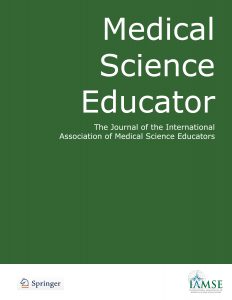
Each month the IAMSE Publications Committee reviews published articles from the archives of Medical Science Educator or of its predecessor JIAMSE. This month’s review, written by Dr. John L. Szarek, is taken from the article titled Development of an Educational Activity for First- and Second-Year Medical Students Using Cadaver Pathologies to Enhance Clinical Reasoning and Prepare for Entrustment in Providing Oral Case Presentations.
The value and importance of human body donations for medical education is a topic of frequent recurrence in medical education literature. These gifts, the students’ first patients, have the potential to provide integrative teaching by medical educators and integrative learning by medical students. This opportunity, however, is not often taken to full advantage. Too often basic science topics such as Pathology are taught separately in distinct courses from Gross Anatomy. This creates a challenge in terms of a student’s ability to integrate the gross anatomical findings with underlying pathological images and mechanisms. One approach to address this challenge is discussed in a recent study entitled: Development of an Educational Activity for First- and Second-Year Medical Students Using Cadaver Pathologies to Enhance Clinical Reasoning and Prepare for Entrustment in Providing Oral Case Presentations, published in Medical Science Educator, Volume 27 (pages 391–399), 2017, by authors Machelle Linsenmeyer, Nina Fallon, Paige Monfore, Holly Berg, Laura Bradel, Edward Bridges and Lourdes Bernardino from the West Virginia School of Osteopathic Medicine, Lewisburg, USA (WVSOM).
WVSOM has developed educational activities, Cadaver Pathology Workshops, that utilize human cadavers to teach students not only about the associated pathologies, but also to enhance their clinical reasoning, peer teaching and self-directed learning skills. Moreover, the design is tethered to sound educational principles, such as adult learning theory and habits of mind, and mapped to the competency of preparing students for entrustment of Entrustable Professional Activity (EPA) 6: “Provide an oral presentation of a clinical encounter” as defined by the Association of American Medical Colleges (AAMC). The five criteria for establishing the design of the activity included: (1) faculty serving as guides while peers help build knowledge; (2) arousing curiosity, personal initiative, and expression of learner ideas through student-initiated events and development of cases; (3) repeated, deliberate exposure to real cases; (4) use of a clinical approach to basic science topics to build habits-of-mind in clinical reasoning; and (5) peer teaching to enhance development in the domains of learning beyond just basic knowledge for the peer teachers.
The WVSOM Pathology Club, under the direction of their faculty advisor, hosted four cadaver pathology workshops for first and second year students over three years. Workshops were designed to complement the patient presentation curriculum of WVSOM. Each of these workshops included: (1) selection of cadaver pathologies by the faculty advisor to enhance learning; (2) preparation for teaching workshops; (3) preparation of clinical scenario; (4) oral case presentation and discussion; (5) creation of a final diagnosis and treatment plan; and (6) debrief/feedback. The workshop preparation was largely student driven under supervision by a Pathologist and Biomedical Science faculty. Preparation took place over 1-2 months and paired 2nd and 1st year students for the creation of the clinical scenario for oral presentation, integrating both basic and clinical science relevant to the case. Each workshop consisted of three to four stations and lasted about 90 min to 2 h. Each student case presentation was preceded by faculty coaching and followed by debriefing and feedback.
The 2nd and 4th workshops were assessed for student satisfaction as to whether the workshop objectives were met, whether the exercise contributed to their understanding of the disease process, and their likelihood of attending another workshop. In addition, for workshop 2 students were asked two questions about presentation skills, and for workshop 4 students were asked questions about likelihood of recommending, and suggestions for improving, the workshops and their favorite diagnosis.
Based on the analysis of the scores and comments, students were satisfied with the sessions and 100% felt that the workshop objectives had been met (Formulate a differential diagnosis based on clinical history and gross examination of the pathology, Integrate knowledge from pathology, physiology, and pharmacology to arrive at a diagnosis and potential treatment plan for the cases presented, Identify the gross or histologic features of the pathology of interest presented for each case, Utilize microscopy techniques, if applicable). Students also particularly appreciated the opportunity to integrate their knowledge and the participation of many faculty.
The authors clearly state the limitations of the study, including failure to analyze the 1st and 3rd workshop, collecting faculty feedback and developing long term evaluation on retention and clinical reasoning skills. But they also point out that this activity of extracurricular and this may be the greatest limitation. It is hoped that this type of educational activity, using the gift of human cadavers for an integrated learning experience, would be supported by medical school administrations and incorporated into official curriculum.
Ann Poznanski, MD, PhD
Member IAMSE Publications Committee
Member IAMSE Board of Directors
Want access to over 40 archived issues and more than 800 medical science articles? Visit Medical Science Educator online here for access to every issue since 2011!